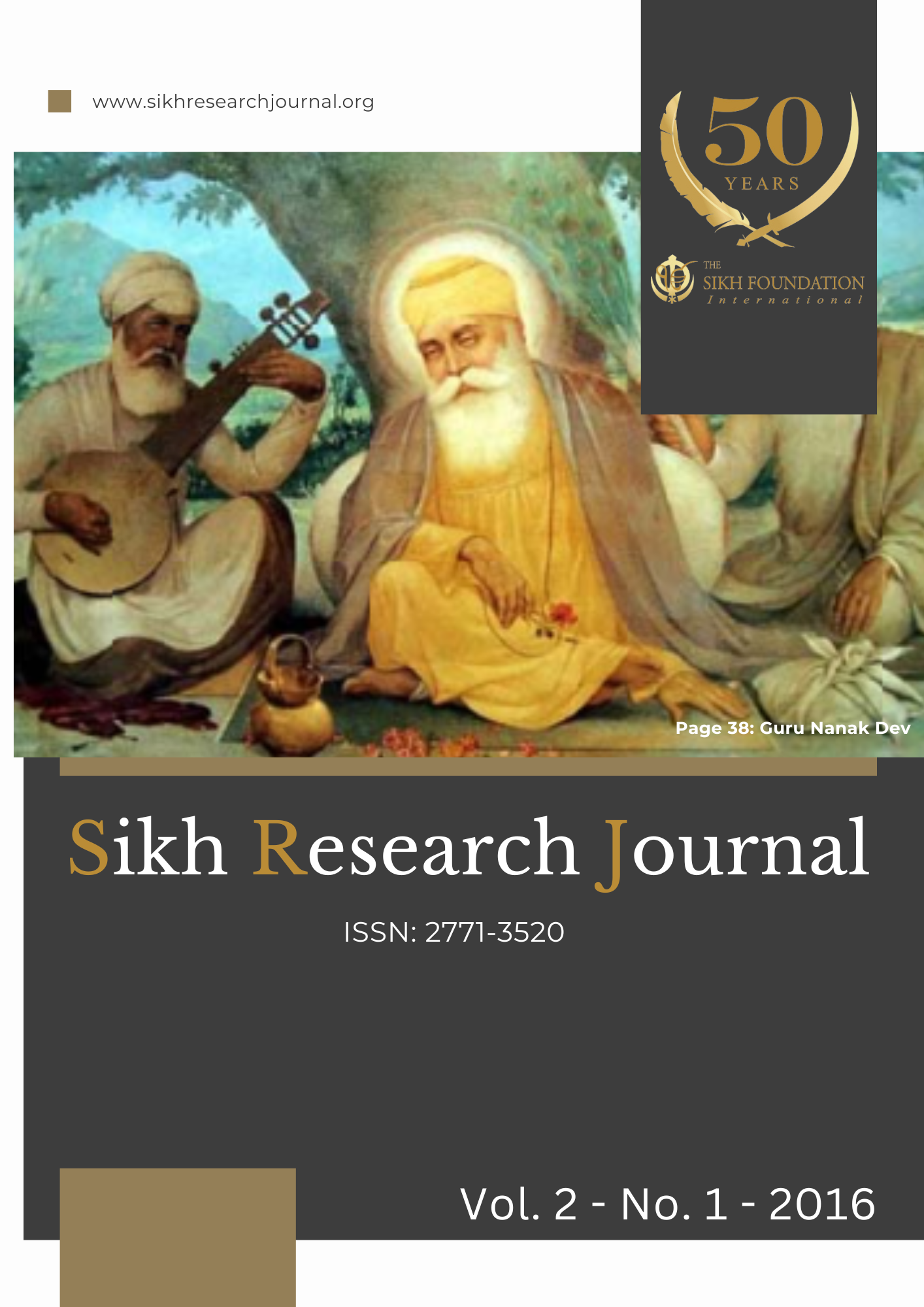Abstract
This research paper traces the genesis and development of Sikh Calendar art/Sikh Popular art which has systematically evolved into a full-fledged genre of Sikh art over the last three centuries as it draws inspiration from the Sikh religion, ethos, philosophical perspectives and glorious history of the Sikhs. The fountainhead of Sikh Calendar art is the pictorial narratives based on Janam Sakhis drawn by the artists engaged by the earlier preachers of Sikhism and it culminated into the formation of handpainted pothis/manuscripts which had text as well as illustrations. This tradition further blossomed as more and more artists were engaged by devout followers of Sikhism to paint walls of shrines, thakurdwaras, deras, sarais, dharamshalas, akharas and havelis in the form of frescoes and murals to spread the message of Sikhism. With the arrival of art of miniature painting by the Rajasthani artists in Kangra, Guler, Chamba, Basohli, Nurpur and Kotla, the Sikh art got further impetus as these artists started adopting Sikh themes to seek greater patronage from the Sikh rulers as Maharaja Ranjit Singh, his courtiers and Sikh aristocrats showed keen interest and appreciation for this classical form of painting which had great aesthetic and artistic merit. The court of Maharaja Ranjit Singh had great splendour and grandeur which attracted hordes of European travelers, artists, generals and historians. The famous European artists brought with them new techniques of painting like oil on canvas, watercolour, pastels, chalk, crayon, woodcut, lithography and zinc etching. These painters profusely painted the Lahore Durbar and portraits of the royalties, generals and aristocrats with photo-realistic technique giving emphasis on proper perspective, three-dimensional aspects, flora and fauna, architecture, weaponry and costumes. As they had brought with them the printing presses, prints of the fabulous paintings started flooding the markets in Lahore and Amritsar. Brilliant Sikh artists who were acting as their helpers whole-heartedly picked up their painting techniques. After attaining proficiency in western painting techniques, they started painting Sikh themes and thus Sikh art developed rapidly with newer and enchanting explorations and innovations. To make their art available to the masses, prints based on paintings of Sikh themes and philosophy were produced in great numbers and sold in bazaars, fairs, festivals in front of the Gurdwaras, temples and shrines. Walls of nearly every Punjabi home and establishment were adorned with these magnificent and colourful Sikh calendars as people adored their thematic content which preached divine and spiritual messages of Sikh Gurus. Generation after generation of artists pursued this genre of art with diligence and deep dedication and today we have a full-fledged flourishing and ever-evolving gene of Sill Calendar art which has typical characteristics and style and it has even reached the shores of many foreign lands where the Sikh and Punjabi Diaspora is settled.References
Inglis, Stephen R; 1995, ‘Suitable for Framing: The Work of a Modern Master’, Media and the Transformation of Religion in South Asia, Pennsylvania University Press, Philadelphia, P.53
Uberoi, Patricia; 2006, Freedom and Destiny: Gender, Family, and Popular Culture in India, Oxford University Press, New Delhi, P.49
Daljeet, Dr; 2004, The Sikh Heritage-A Search for Totality, Prakash Book Depot, New Delhi, P.118
McLeod, W.H; 1991, Popular Sikh Art, Oxford University Press, Oxford, New York, P.4
Fauja Singh, Dr.; March 1969, A Study of the paintings of Guru Nanak, Punjab History Conference Proceedings, 4th Session, Patiala, P. 131
Daljeet, Dr.; 2004, The Sikh Heritage-A Search for Totality, Prakash Book Depot, New Delhi, p.118
Ibid, P.131
Archer, W.G; 1966, Paintings of the Sikhs, Her Majesty’s stationary office, London, P.31
Randhawa, M.S; 1971, Sikh Painting, Roopalekha, Vol. 39, No.1, AIFACS, New Delhi, P.21
Fauja Singh, Dr.; March 1969, A Study of the paintings of Guru Nanak, Punjab History Conference Proceedings, 4th Session, Patiala, P 134
Archer, W.G; 1966, Paintings of the Sikhs, Her Majesty’s stationary office, London, P.31
Goswamy, B.N; 1981, A matter of taste: Some Notes on the context of Painting in Sikh Punjab, Marg Publications, Bombay, P.67
Aryan, K.C; 1975, Punjab Painting, Punjabi University, Patiala, P.17
Ibid, P.20
Kessar, Urmi; June 2003, Twentieth-Century Sikh Painting: The Presence of the Past. In Kavita Singh, Ed. New Insights into Sikh Art, Marg Publications, P.121
McLeod, W.H; 1991, Popular Sikh Art, Oxford University Press, Oxford, New York, P.20-21
Daljeet, Dr.; 2004, The Sikh Heritage-A Search for Totality, Prakash Book Depot, New Delhi, p.119
Fauja Singh, Dr.; March 1969, A Study of the paintings of Guru Nanak, Punjab History Conference Proceedings, 4th Session, Patiala, P .144
Photographs Courtesy:
Plate No. 1- www.sikhmuseum.com
Plate No. 2- Government Museum and Art Gallery, Chandigarh
Plate No. 3- www.sikhmuseum.com
Plate No. 4- Government Museum and Art Gallery, Chandigarh
Plate No. 5- Central Sikh Museum, Golden Temple, Amritsar
Plate No. 6- Government Museum and Art Gallery, Chandigarh
Plate No. 7- Government Museum and Art Gallery, Chandigarh
Plate No. 8- Central Sikh Museum, Golden Temple, Amritsar
Plate No. 9- Government Museum and Art Gallery, Chandigarh
Plate No. 10- Government Museum and Art Gallery, Chandigarh
Plate No. 11- Government Museum and Art Gallery, Chandigarh
Plate No. 12- Artist G.S. Sohan Singh
Plate No. 13- Government Museum and Art Gallery, Chandigarh
Plate No. 14- Government Museum and Art Gallery, Chandigarh
Plate No. 15- Government Museum and Art Gallery, Chandigarh
Plate No. 16- Government Museum and Art Gallery, Chandigarh

This work is licensed under a Creative Commons Attribution-NonCommercial-ShareAlike 4.0 International License.
Copyright (c) 2025 Dr. Kavita Singh

